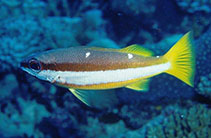
|
Lutjanus biguttatus (Valenciennes, 1830) Two-spot banded snapper |
||
| Dayangdang batuhan, Kitkit, Two-spot snapper, Admon, Agba-on, Alsis, Aluman, Awnan, Bad-lisan, Bambangon, Bangayau, Dalangdang, Dapak, Gingau, Gingaw, Guntul, Kanulo, Katambak, Labongan, Labungan, Lambiyao, Langisi, Madarag, Malaponti, Managat, Mandagat, Matangal, Maya maya, Maya-maya, Mayaguno, Pargito, Puga, Pulahan, Saiya, Sayungasang, Sidinean, Tabon | ||

|
|
photo by
Field, R. |
| Family: | Lutjanidae (Snappers), subfamily: Lutjaninae | |||
| Max. size: | 25 cm TL (male/unsexed) | |||
| Environment: | reef-associated; marine; depth range 3 - 36 m | |||
| Distribution: | Indo-Pacific: mainly the Indo-Australian Archipelago from the Solomon Islands to Sumatra, and from off Cape York Peninsula, Australia, northward to the Philippines; also occurring in the central and eastern Indian Ocean as far west as Maldives. | |||
| Diagnosis: | Dorsal spines (total): 11-11; Dorsal soft rays (total): 12-12; Anal spines: 3-3; Anal soft rays: 8-8. Snout profile low, sloping very gently. Preorbital bone narrow, its width less than half of eye diameter. Preopercular notch and knob poorly developed. Scale rows on back rising obliquely above lateral line. Generally dark brown of the upper part of the head and body with a broad white horizontal band immediately below. The lower part of the head and body dusky brown with a suffusion of yellow. A pair of white spots is on the back just below the dorsal fin base (Ref. 469). Description: Adults dorsal grey or dark brown, ventral dusky brown with suffusion of yellow, midlateral broad horizontal stripe white; spots 2 white below dorsal fin base. Juveniles dorsal and ventral white, midlateral broad horizontal stripe dark brown, spots 2 white faint. Body extremely slender (for the genus), depth max 3.5-3.8. Snout profile low, sloping very gently. Preorbital bone narrow, width less than half of eye diameter. Preopercular notch and knob indistinct. Dorsal scale rows rising obliquely above LL. (Ref. 469, 90102) | |||
| Biology: | Adults inhabit coral reefs (Ref. 9710, 48635) and outer reef slopes (Ref. 37816, 48635). They sometimes form large schools of more than 100 individuals. Often solitary (Ref. 48635). Feed mainly on small fishes and crustaceans. Generally uncommon (Ref. 9710). | |||
| IUCN Red List Status: | Least Concern (LC); Date assessed: 04 March 2015 Ref. (130435) | |||
| Threat to humans: | harmless | |||
| Country info: | Recorded in Tañon Strait (Ref. 107276) and Nasugbu, Batangas (Ref. 107853). Known from Bulata, Negros Occidental (Ref. 58652), Bongo Island, Moro Gulf (Ref. 106380), and Bantayan Is. in northern Cebu (Ref. 114734). Also Ref. 55, 48613, 53416, 59110, 121724. | |||